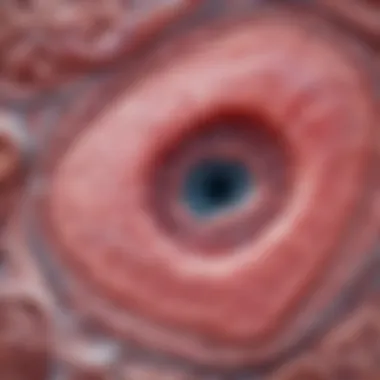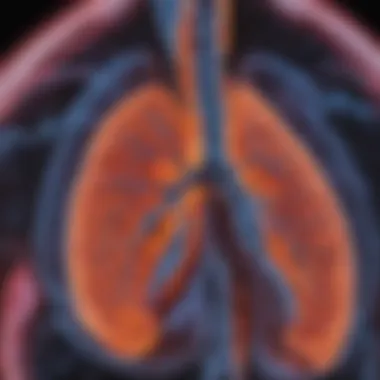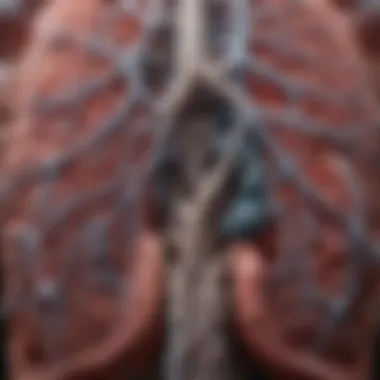Understanding UIP Pattern in Interstitial Lung Disease


Intro
Interstitial lung disease (ILD) encompasses a broad range of lung disorders that result in varying degrees of inflammation and scarring in the lung tissue. Among these conditions, the Usual Interstitial Pneumonia (UIP) pattern stands out due to its critical clinical implications. Recognizing, understanding, and properly diagnosing UIP is vital for patient outcomes, particularly because it often serves as a radiological pattern observed in a number of underlying diseases, including idiopathic pulmonary fibrosis and connective tissue diseases.
Grasping the subtleties of the UIP pattern can be daunting. The pattern itself manifests through a mix of typical radiological features, clinical signs, and histopathological findings. This intricate interweaving of symptoms and imaging can lead even experienced practitioners down a rabbit hole of diagnostic uncertainty. Thus, having a comprehensive overview of this topic is not only beneficial but imperative for those working in respiratory medicine.
In this article, we dive into the murky waters of UIP within ILD, shedding light on its diagnostic conundrums and clinical relevance. By breaking down the complexities surrounding UIP, from its underlying mechanisms to current research advancements, we aim to equip readers with the knowledge they need to navigate this challenging area effectively.
Let's explore the methodology, discussion, and future directions regarding the UIP pattern in interstitial lung disease, which will help clarify its significance in clinical practice and ongoing research.
Prelude to Interstitial Lung Disease
Interstitial Lung Disease (ILD) encompasses a broad spectrum of pulmonary disorders primarily characterized by the scarring, or fibrosis, of lung tissue. This scarring interferes with the lungs’ ability to function effectively, leading to a host of debilitating symptoms and significant morbidity. Understanding ILD is crucial, as it lays the groundwork for comprehending more specific patterns within the disease, such as the usual interstitial pneumonia (UIP) pattern. This particular pattern plays a pivotal role in identifying underlying causes, determining prognosis, and guiding management strategies.
Delving into the realm of ILD allows healthcare professionals and researchers to address the nuances of diagnosis, treatment, and patient care. The growing recognition of ILD's impact on lung function and quality of life has spurred interest in both clinical and basic research. In this article, we aim to illuminate the intricate web of knowledge surrounding ILD, specifically targeting the UIP pattern, and its implications on patient outcomes and therapeutic innovations.
Defining Interstitial Lung Disease
Interstitial Lung Disease is not merely a singular disorder; it is an umbrella term that encapsulates over a hundred different conditions. Each of these conditions has its unique pathophysiology, clinical presentation, and treatment approaches. At its heart, ILD is a term for lung diseases that predominantly affect the interstitium, the tissue surrounding the air sacs in the lungs. This tissue thickening leads to inflammation and fibrosis—two processes that significantly alter normal lung function. A clear understanding of the characteristics of ILD is vital, particularly as it enables healthcare professionals to identify symptoms and initiate treatments more effectively.
Prevalence and Impact
The prevalence of interstitial lung diseases has been on the rise, drawing attention from the medical community. Factors such as increasing environmental exposure to pollutants, occupational hazards, and aging populations contribute to this uptick. According to recent estimates, conditions like Idiopathic Pulmonary Fibrosis (IPF) alone may affect 5 million people globally, showcasing the burden of disease.
The impact of ILD is profound, influencing not just the patients but also their families and healthcare systems. Patients often experience a progressive decline in lung function, leading to a reduction in their ability to engage in daily activities, which can contribute to psychological distress. Moreover, the healthcare costs associated with managing ILD and its complications are significant, further emphasizing the need for thorough understanding and targeted research.
"Understanding interstitial lung disease is key to advancing treatment options and improving life quality for millions sufferings."
In summary, a detailed exploration of Interstitial Lung Disease, beginning with fundamental definitions and its increasing prevalence, sets the stage for a focused examination of the UIP pattern. Such an understanding is not just academic; it establishes the foundation for better clinical practices and ultimately enhances patient outcomes.
Understanding UIP Pattern
The UIP pattern, or Usual Interstitial Pneumonia pattern, holds a pivotal role in the context of interstitial lung disease (ILD), serving as a critical indicator in the broader diagnostic landscape. It is more than just a set of findings on imaging studies; it speaks volumes about the underlying pathology and can suggest a range of clinical implications. Recognizing the significance of UIP is crucial for healthcare providers and researchers alike, as it often reflects progressive lung fibrosis, which can lead to severe morbidity.
The nuances of the UIP pattern can shape treatment decisions, guide patient counseling, and potentially predict outcomes. Understanding these patterns might not only streamline diagnostic processes but also illuminate therapeutic avenues that could mitigate disease progression.
Characteristics of UIP Pattern
One distinct hallmark of the UIP pattern lies in its presentation on imaging studies, specifically high-resolution computed tomography (HRCT). Characteristics that set UIP apart include:
- Subpleural distribution: The lower lobes are commonly affected.
- Honeycombing: Appears as cystic spaces, a characteristic feature in advanced cases.
- Reticular opacities: These fine, linear streaks represent fibrosis.
- Ground-glass opacities: Often noted, these suggest areas of inflammation or partial lung collapse.
It’s vital for clinicians to understand these specific characteristics when assessing a patient. As the saying goes, a picture is worth a thousand words, and in this case, the imaging can guide the clinical narrative significantly.
Histopathological Features
When diving into histopathological findings, the UIP pattern reveals several key features typical of the disease process:
- Fibrosis: How it manifests in a temporal and spatial inconsistency can enlighten us on disease progression.
- Hyaline membranes: Often seen in the alveolar spaces, they're part of the lung's repair response.
- Increased mononuclear cells: These are typically found within the interstitium, playing a role in the inflammatory response.
The examination of lung biopsy specimens often confirms the UIP diagnosis. The presence of temporal variability in fibrosis—focal regions of dense collagen, mixed with areas showing less mature fibrosis—is especially telling. This histological examination serves not only to solidify the diagnosis but also to reveal insights into the inflammatory mechanisms at play.
"Histopathological examination can serve as a roadmap for understanding the patient's journey through fibrotic lung disease."


The integration of these clinical and histological insights provides a robust framework for interpreting UIP, ultimately informing better patient management strategies throughout the treatment course.
Clinical Implications of UIP Pattern
The UIP pattern plays a critical role in understanding interstitial lung disease, particularly with its implications for clinical practice. This pattern not only affects diagnosis but also influences the management of patients, their symptoms, and prognostic outcomes. Recognizing its significance can lead to earlier interventions, timely support, and better overall patient care.
Patient Symptoms and Presentation
When it comes to patient symptoms, the UIP pattern often manifests through a series of respiratory complaints. Patients typically present with:
- Progressive Dyspnea: This symptom often worsens over time, making it difficult for patients to perform daily activities.
- Chronic Dry Cough: A persistent cough that doesn't yield much, can be quite debilitating.
- Fatigue: Many patients report feeling more tired than usual, which could be due to the body’s struggle to compensate for reduced lung function.
In clinical settings, patients may express descriptions like feeling "out of breath like they just ran a marathon," even when doing simple tasks. It’s essential for healthcare providers to distinguish these symptoms from other respiratory conditions, as this distinction could change management approaches significantly.
Prognostic Significance
Assessing the prognostic significance of the UIP pattern reveals its daunting implications for patient outcomes. Historically, patients diagnosed with UIP have a significantly different prognosis compared to those with other interstitial lung patterns. Some key points include:
- Survival Rates: Research indicates that patients with idiopathic pulmonary fibrosis displaying a UIP pattern typically have a median survival of 3 to 5 years post-diagnosis. The prognosis may be more favorable if diagnosed early, emphasizing the need for prompt recognition.
- Response to Treatment: The UIP pattern influences how a patient may respond to treatments, especially antifibrotic agents. For example, studies have shown that those diagnosed early receive better therapeutic responses, possibly due to lesser extent of lung damage.
- Need for Lung Transplantation: The presence of UIP can escalate the urgency for lung transplantation, as it tends to progress more aggressively compared to other interstitial patterns.
"Recognition of UIP patterns can be the key to unlock better management strategies and prognostic clarity for patients."
Understanding the clinical implications of the UIP pattern becomes a roadmap for managing interstitial lung disease more effectively. Clinicians must appreciate how this pattern influences diagnosis and treatment approaches to provide more comprehensive care for their patients.
Diagnosis of UIP Pattern
Diagnosing the UIP pattern is a cornerstone in the management of interstitial lung disease (ILD). Accurate diagnosis not only informs treatment but also has significant prognostic implications. Given the overlapping features of various ILDs, a clear understanding of the UIP pattern is crucial for clinicians.
Key Aspects of Diagnosis:
- Identifying Characteristics - Health professionals must recognize the distinct radiological and histological features of UIP. This presents a pathway to differentiate it from other patterns.
- Multidisciplinary Approach - Engaging specialists from radiology, pathology, and pulmonary medicine can enhance diagnostic accuracy and patient outcomes.
- Patient History and Symptoms - A thorough patient history and clinical symptomatology provide substantial clues that guide the diagnostic process.
In essence, the significance of diagnosing the UIP pattern hinges on the potential to tailor the management approach effectively, reducing the risk of misdiagnosis and optimizing therapeutic strategies.
Differential Diagnosis
In the intricate landscape of interstitial lung disease (ILD), understanding the differential diagnosis is vital. This part helps clinicians to pinpoint the subtle differences between various patterns of lung pathology, especially when it comes to the usual interstitial pneumonia (UIP) pattern. Correctly identifying UIP can ultimately affect patient management and treatment approaches, making it an essential focus in this article.
Distinguishing UIP from other patterns is often no walk in the park. It involves a keen understanding of clinical features, characteristic pulmonary function tests, and specific imaging findings. The implications of getting it right are significant. Misdiagnosis can lead to inappropriate treatment, which can be detrimental and may worsen a patient’s quality of life. Having the right diagnosis upfront can streamline the approach to therapy and enhance patient outcomes.
Moreover, understanding the common disorders that present with UIP features is integral. This enables clinicians to consider a broader scope of conditions and tailor management strategies accordingly. By delving into these aspects, we can glean insights that are not only academically rigorous but also practically beneficial in the realm of ILDs.
Distinguishing UIP from Other Patterns
When clinicians evaluate a patient suspected of having UIP, they often face an array of differential diagnoses. Differentiating UIP from other interstitial pneumonia patterns such as nonspecific interstitial pneumonia (NSIP) or acute interstitial pneumonia is key. Each of these has unique features that, if recognized early, can direct management in the right direction.
For example,
- UIP is characterized by patchy fibrosis and honeycombing on imaging, often with a basilar gradient.
- In contrast, NSIP presents with a more uniform distribution of ground-glass opacities and is typically less severe in presentation than UIP.
Understanding these core differences ensures that treatment modalities align correctly with the patient's condition. Increasing awareness around these patterns allows for a more educated approach to lung disease management.
Common Disorders with UIP Features
The overlap between various disorders and the UIP pattern can be a source of confusion. A few notable conditions include:


- Idiopathic Pulmonary Fibrosis
- Scleroderma-related ILD
Idiopathic Pulmonary Fibrosis
Idiopathic Pulmonary Fibrosis (IPF) is perhaps the most well-known condition associated with UIP. One particular aspect that stands out is its progressive nature. Patients often experience gradual deterioration in lung function, making prompt identification and management critical.
A key characteristic of IPF to note is that it is categorized as a chronic and irreversible disease. This alone makes it a focal point of our article as early recognition can significantly impact patient quality of life and survival.
The unique feature of IPF, compared to other lung diseases, is its tendency to manifest in older adults, often following a pattern of intermittent exacerbations. This can pose diagnostic challenges, but also emphasizes the need for vigilance in monitoring patient progress. Thus, having an understanding of IPF’s characteristics enriches the discussion surrounding UIP and its implications in the clinical setting.
Scleroderma-related
Another significant disorder is scleroderma-related ILD. The link between these two is particularly fascinating, as scleroderma can present with various pulmonary manifestations. The key characteristic here is how it often leads to fibrosis as part of its systemic presentation.
Scleroderma-related ILD tends to exhibit features similar to UIP, but associated symptoms may include skin changes or esophageal dysfunction, which allows physicians to build a more comprehensive clinical picture.
This condition frequently complicates the clinical landscape, as the lung fibrosis seen in scleroderma can sometimes mislead clinicians to lean towards a UIP diagnosis without recognizing the systemic aspects at play. In this context, understanding the nuances between UIP and scleroderma-related ILD empowers physicians to differentiate the two more effectively, leading to targeted and appropriate management for the patient.
Ultimately, a solid grasp of differential diagnoses concerning UIP is not just academic trivia; it shapes the very framework through which we approach treatment and patient care.
Management Strategies and Treatments
Management of the UIP pattern in interstitial lung disease is a complex yet vital aspect of treatment approaches. Given the diverse nature of interstitial lung diseases (ILD) and the unique presentation of the UIP pattern, strategies and treatments must be tailored to meet individual patient needs. Understanding these management options is crucial for optimizing outcomes, alleviating symptoms, and enhancing the quality of life for patients grappling with this diagnosis.
Medications and Therapeutics
Antifibrotic Agents
Antifibrotic agents have gained significant attention in recent years for their role in managing the progression of UIP, particularly in idiopathic pulmonary fibrosis. Two main antifibrotic medications, pirfenidone and nintedanib, have been pivotal in clinical settings.
The primary characteristic of antifibrotic agents is their ability to slow down lung function decline. By interfering with the excessive accumulation of extracellular matrix components, they help abate the pathological scarring of lung tissue associated with UIP. This characteristic positions them as beneficial choices in this context.
One unique feature of these medications is their dual mechanism of action. For instance, pirfenidone not only inhibits fibrosis but also exhibits anti-inflammatory properties, addressing multiple facets of the disease pathophysiology. However, their advantages come with certain downsides, such as potential side effects like gastrointestinal disturbances or skin rashes, which may limit their use in some patients.
Immunosuppressants
Immunosuppressants play a different but equally vital role in managing UIP, particularly in patients whose conditions stem from autoimmune diseases. Drugs like mycophenolate mofetil and azathioprine are commonly utilized to mitigate inflammatory responses contributing to lung damage.
A key characteristic of these agents is their ability to dampen the immune response. This feature makes them highly valued for individuals with underlying autoimmune conditions linked to UIP, such as scleroderma or rheumatoid arthritis. They help in reducing inflammation and subsequent progression of lung fibrosis.
However, one unique aspect of immunosuppressants is the requirement for close monitoring due to their potential to increase the risk of infections and other complications. This aspect brings a consideration of trade-offs, as while they may help preserve lung function, the risk profile demands careful patient selection and management.
Palliative Care Approaches
In conjunction with medical therapies, palliative care is an increasingly integrated part of managing patients with UIP. Palliative care focuses on enhancing the quality of life for patients by addressing not just the physical aspects of the disease, but also emotional, spiritual, and social needs.
This approach allows healthcare providers to cater to symptoms like dyspnea, fatigue, and chronic cough more effectively. Techniques may include:
- Supplemental oxygen therapy to alleviate breathing difficulties.
- Physical therapy to enhance mobility and functionality.
- Counseling support to help patients cope with the psychological impact of living with a chronic illness.
Moreover, an interdisciplinary team approach ensures that care is comprehensive. This collaborative model includes not just physicians, but also nurses, social workers, and spiritual care providers working together. Ultimately, palliative care plays a crucial role in improving the overall experience for patients facing the challenges brought on by the UIP pattern.
Recent Advancements in Research


The realm of interstitial lung disease, particularly the UIP pattern, is witnessing a sea change due to recent advancements and research initiatives. This section digs into significant developments, revealing how they reshape our understanding and management of UIP. By focusing on innovative strategies and the resulting benefits, clinicians and researchers alike can grasp the evolving landscape of this intricate condition.
Genetic and Molecular Insights
Recent studies are shedding light on the genetic underpinnings of UIP. Understanding the molecular basis enables researchers to identify specific biomarkers that reflect disease progression. For instance, mutations in the TERT and TERC genes often surface in patients with idiopathic pulmonary fibrosis, a common context for UIP. These genetic markers not only help in diagnosing but also in prognosticating patient outcomes.
Moreover, advancements in genomic sequencing technologies facilitate personalized treatment approaches. By analyzing the molecular profiles of patients, clinicians can tailor therapies that target specific pathways involved in fibrosis. This tailored approach is crucial; many standard treatments offer minimal benefit, which highlights the necessity of shifting towards more individualized strategies.
Emerging Treatment Modalities
Cell-Based Therapies
Cell-based therapies are making waves in the treatment landscape for UIP. Specifically, mesenchymal stem cells (MSCs) are garnering attention for their potential to regenerate lung tissue and reduce fibrosis. What sets these therapies apart is their ability to modulate the immune response and promote repair, effectively addressing the underlying pathophysiology of UIP. This regenerative capacity is seen as a beacon of hope, providing a more holistic approach rather than simply managing symptoms.
However, while MSC therapy is promising, it is still in the early stages of clinical applicability. Several factors complicate its broad use, such as varying sources of stem cells, the need for standardized protocols, and potential ethical dilemmas. Therefore, while they offer a bright horizon in treating interstitial lung disease, more research is essential to optimize their use and ensure patient safety.
Novel Drug Trials
On the pharmaceutical front, novel drug trials are pivotal in discovering new treatments for UIP. Recent clinical trials investigating tyrosine kinase inhibitors and immune modulators have shown promise. These agents specifically target pathways involved in inflammation and fibrosis, aiming to alter the disease trajectory effectively.
A standout feature of these trials is their focus on reducing disease progression and improving quality of life, rather than just prolonging survival. Patients enrolled in these trials often experience fewer side effects compared to traditional therapies, indicating a potential shift towards more tolerable treatment regimens.
Yet, it's essential to acknowledge the limitations of this approach. The complexity of interstitial lung disease means that not every novel drug may translate into meaningful improvements for all patients. Structural differences in disease manifestation often require a diversified arsenal of treatment options to cater to varied patient needs.
"The future of UIP treatment is leaning towards a more personalized and genetic approach, shifting from traditional one-size-fits-all treatments to more precise, tailored strategies."
Future Directions in UIP Research
The realm of Usual Interstitial Pneumonia (UIP) research is ripe with possibilities. As our understanding of interstitial lung disease evolves, so too does the significance of exploring further avenues of investigation. This section aims to highlight key aspects that could potentially enhance our comprehension and treatment of UIP. Focusing on innovative avenues and collaborative efforts, we can open doors to more effective interventions.
Potential Areas of Exploration
The horizon of UIP research is expansive, with numerous pathways waiting to be explored. Preliminary investigations could focus on:
- Biomarkers for Early Detection: Identifying reliable biomarkers could facilitate early diagnosis, providing critical time for management before significant lung damage occurs.
- Genomic Studies: Delving into the genetic underpinnings of UIP will likely yield insights into its etiology and progression, pointing researchers toward targeted therapies that tackle the specific pathways involved.
- Microbiome Analysis: The role of the lung microbiome in UIP could be a potential game-changer. Understanding how microbial communities influence the disease may contribute to new therapeutic approaches, possibly leveraging beneficial bacteria to mitigate symptoms.
- Longitudinal Studies: Conducting extensive longitudinal studies would help track UIP's progression over time, offering invaluable data on disease course and treatment responsiveness.
- Innovative Imaging Techniques: Novel imaging modalities and techniques should be explored. They could provide more detailed assessments of lung architecture and function, enhancing diagnostic accuracy and therapy monitoring.
"Exploring biomarkers may just be the key we need in unlocking the complex nature of UIP, allowing for early stage interventions that could change patients' lives."
Interdisciplinary Collaboration
Many heads are better than one. Collaboration across disciplines can amplify research efforts related to UIP. Here are some critical components to consider:
- Combining Expertise: Bringing together pulmonologists, radiologists, geneticists, and bioinformaticians fosters a comprehensive approach to investigate the multifaceted nature of UIP. Each discipline offers unique insights that, when combined, can lead to breakthroughs.
- Patient-Centered Research: Engaging patients in the research process ensures that studies align with their needs and experiences. This participatory approach not only enhances relevance but also fosters motivation among researchers.
- Funding Opportunities: Collaboration can create avenues for securing funding from various sources, including governmental organizations and private sectors. Pooling resources often leads to larger-scale projects that can produce more significant results.
- Data Sharing: Establishing networks for sharing data will enhance the quality of research. By accessing a broader data set, researchers can make informed conclusions and expedite innovation in treatment protocols.
- Global Partnerships: As UIP does not discriminate across borders, forming global partnerships could facilitate diverse perspectives and methodologies, enriching the research landscape.
Finale
The discussion surrounding the UIP pattern in interstitial lung disease serves as a critical juncture where clinical practice meets ongoing research. Understanding this pattern is not just a matter of academic interest; it has tangible implications for the treatment and management of patients. By unraveling the nuances associated with UIP, we can pinpoint strategies that enhance patient outcomes and refine approaches to diagnosis and therapy.
One of the core elements discussed is the recap of key points, which encapsulates the essential information regarding the characteristics of UIP, its diagnostic criteria, and treatment modalities available. These insights provide a framework for both novice and seasoned healthcare professionals to navigate the complexities of interstitial lung disease more confidently.
Recap of Key Points
- Characteristics of UIP: The unique features of UIP pattern, including typical radiological findings observed on imaging studies, help in early identification.
- Diagnostic Techniques: High-resolution CT scans and lung biopsies are pivotal in confirming UIP, guiding treatment decisions.
- Clinical Implications: Understanding how UIP manifests across various interstitial lung diseases informs prognosis and potential therapeutic interventions.
- Emerging Research: Advances in molecular biology and potential new treatments highlight the dynamic landscape of ILD therapy.
In summary, each aspect covered contributes vitally to a comprehensive understanding of UIP in interstitial lung disease, allowing healthcare providers to apply this knowledge directly to their clinical practices.
The Importance of Ongoing Research
The landscape of interstitial lung disease is continually evolving. Ongoing research plays a crucial role in shaping our understanding of UIP. Innovations in genetic and molecular research foster new approaches to disease management, while emerging therapies hold promise for improved patient outcomes.
- Insights from Recent Studies: Clinical trials and research studies contribute valuable data that can refine existing treatment protocols and inform future ones.
- Collaboration Across Disciplines: Interdisciplinary collaboration is vital for breaking down the silos in medical research. Integrating perspectives from pulmonology, radiology, and pathology enables a more holistic approach to managing UIP.
- Patient-Centered Research: Ongoing studies that focus on patient outcomes will ensure that treatments are not only effective but also aligned with patient needs and quality of life considerations.







